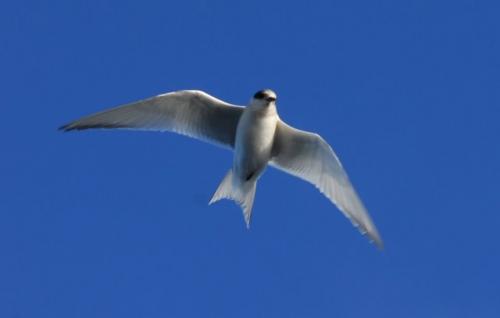Antarctica - Arctic Tern vs. Wandering Albatross - Which is the Winner?

Arctic Tern - Long Distance Migrant
The Wandering Albatross has a number of claims to fame. It has the smallest clutch size of any bird in the world (one egg every two years); they take the longest time to reach breeding maturity (6 to 10 years), and … they have amazing wings! With a total wingspan of 3.45 metres (over 11 feet) the Wandering Albatross has the widest wingspan of any bird in the world. The widest wings ever recorded were from a bird captured in the Tasman Sea near New Zealand measuring 3.63 metres (11 feet 11 inches). This is huge when you consider that the wingspan of a Bald Eagle is about 2.0 metres (6.7 feet).

Wandering Albatross. Widest wingspan of any living bird!
The Wandering Albatross though is not only incredible because of its wingspan but I would say more so because of what it can do with those wings…. fly! Wandering albatross are noted for their long distance flights – in fact they are considered by some to be one of the world champions of long distance flying.
Wandering albatross nest on islands. Both sexes incubate the single egg and once hatched the parents take turns heading off on foraging flights to find food to feed their ever hungry chick. Using satellite telemetry scientists have learned that some parent birds fly as much as 1000 kilometres (600 miles) per day (yes, per day!), covering anywhere from 2900 kilometres (1800 miles) to an astonishing 15,000 kilometres (9,300 miles) in a single foraging flight! That is almost comparable to flying from Vancouver to New York City and back, TWICE… just for a feast of seafood. Once food has been found they return to the nest and the chick is fed by regurgitation (just as in penguins).
Another contender for the title of champion long distance flyer is the Artic Tern. On our last day in Antarctica I was able to observe and photograph one individual which was a real treat. We also saw lots of Antarctic Terns during our visit to the Antarctica Peninsula (which is a very similar looking bird) but it is quite easy to distinguish between the two species during the southern hemisphere summer because Antarctic Terns are in their summer breeding plumage (feathers) while the Arctic Terns are in their non-breeding (less bright or striking) plumage.

Arctic Tern in Summer Breeding Plumage (Photo from Spitsbergen, Norway)
The Arctic Tern is a classic example of a Global Connection species. They breed in the Arctic of Canada, Alaska, Europe and Asia (and occasionally in northern British Columbia) during the northern hemisphere summer and then once fall arrives they start migrating south all the way to Antarctica. The Arctic Tern has the longest annual migration of any bird in the world, flying on average 35,000 kilometres (22,000 miles) round trip each year.
Because they fly from summer to summer year after year Arctic Terns likely experience more daylight hours than any other living thing on the planet. And to top it off, since Arctic Terns can survive into their 20s (and sometimes longer) some individuals will travel over 700,000 kilometres in their lifetimes! Pretty amazing!
 Funded by TEK
Funded by TEK